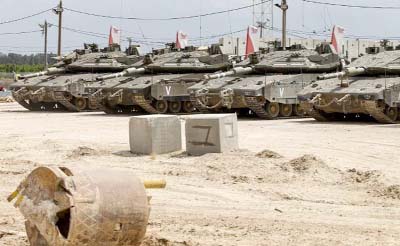
AFP, Gaza City :
Instead of going to school, Walid and Ibrahim spend hours each day rummaging through houses destroyed in Gaza’s wars in search of scrap to raise a few shekels for their families.
They were once good students but Walid Maaruf, 11, and Ibrahim Ghaben, 12, had to quit school and earn a living when their fathers lost their jobs.
Israel and Palestinian terrorists in the Gaza Strip have fought three wars since 2008, including a devastating 50-day conflict in 2014 in the tiny Mediterranean territory.
Residents have lived under a punitive Israeli blockade imposed 10 years ago and their options are further limited by Egypt, which has largely kept its border with Gaza closed since 2013.
Nearly half the enclave’s 1.9 million inhabitants live under the poverty line, with 80 percent surviving on humanitarian aid.
Unemployment has risen dramatically to reach around 45 percent (one of the highest in the world) forcing many children to become bread-winners.
On Sunday, the International Labour Organization marks World Day Against Child Labour, an initiative that has seen the number of child labourers drop to 168 million from 246 million in 2000. But in Gaza the trend has been upward.
According to Palestinian estimates, child labour has doubled over the past five years, with 9,700 children aged between 10 and 17 now working in the enclave.
“My father is unemployed, he used to gather stones and scrap metal… but now I work,” said Ibrahim who earns about 20 shekels ($5) a day toiling six to 12 hours to feed his family of nine. The boy, who looks much older than his age, said he and his father used to transport their find on a donkey-drawn cart “but the donkey died”.
All day long, often under a searing sun or howling wind, boys like Walid and Ibrahim scour flashpoint Beit Lahiya-near the border fence with Israel in northern Gaza-for scrap to sell to recycling firms.
The area is attractive because of potential finds of lead from Israeli munitions, but also carries the risk of drawing gunfire from border guards.
“Most of the children who work do so in neighbourhoods along the border fence, and these are the poorest areas,” said psychologist Aida Kassab from the Gaza Community Mental Health Programme.
Instead of going to school, Walid and Ibrahim spend hours each day rummaging through houses destroyed in Gaza’s wars in search of scrap to raise a few shekels for their families.
They were once good students but Walid Maaruf, 11, and Ibrahim Ghaben, 12, had to quit school and earn a living when their fathers lost their jobs.
Israel and Palestinian terrorists in the Gaza Strip have fought three wars since 2008, including a devastating 50-day conflict in 2014 in the tiny Mediterranean territory.
Residents have lived under a punitive Israeli blockade imposed 10 years ago and their options are further limited by Egypt, which has largely kept its border with Gaza closed since 2013.
Nearly half the enclave’s 1.9 million inhabitants live under the poverty line, with 80 percent surviving on humanitarian aid.
Unemployment has risen dramatically to reach around 45 percent (one of the highest in the world) forcing many children to become bread-winners.
On Sunday, the International Labour Organization marks World Day Against Child Labour, an initiative that has seen the number of child labourers drop to 168 million from 246 million in 2000. But in Gaza the trend has been upward.
According to Palestinian estimates, child labour has doubled over the past five years, with 9,700 children aged between 10 and 17 now working in the enclave.
“My father is unemployed, he used to gather stones and scrap metal… but now I work,” said Ibrahim who earns about 20 shekels ($5) a day toiling six to 12 hours to feed his family of nine. The boy, who looks much older than his age, said he and his father used to transport their find on a donkey-drawn cart “but the donkey died”.
All day long, often under a searing sun or howling wind, boys like Walid and Ibrahim scour flashpoint Beit Lahiya-near the border fence with Israel in northern Gaza-for scrap to sell to recycling firms.
The area is attractive because of potential finds of lead from Israeli munitions, but also carries the risk of drawing gunfire from border guards.
“Most of the children who work do so in neighbourhoods along the border fence, and these are the poorest areas,” said psychologist Aida Kassab from the Gaza Community Mental Health Programme.

